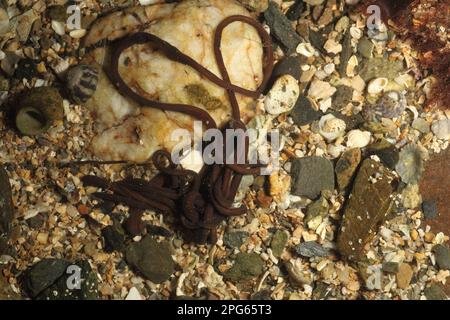
Bootlace worms are not just long; they’re also delicate and can be sensitive to their environment. Approaching them requires a gentle hand, which might sound a little like common sense, but you’d be surprised how easy it is to inadvertently disturb them while exploring. So grab your curiosity, and let’s dive into how to safely observe bootlace worms in tide pools.
Understanding Bootlace Worms
Bootlace worms, known scientifically as *Lineus longissimus*, are part of the nemertean family, also called ribbon worms. They’re typically found in intertidal zones and can be spotted during low tide. These creatures have a unique body structure, which allows them to move smoothly through sand and against rocks. Picture a squirming ribbon, and you get the idea!
You might wonder what makes these worms so special. For starters, they can regenerate lost body parts. This means if they’re harmed, they can grow those parts back, making them quite resilient. Plus, their vibrant colors can range from yellow to brown, often with striking patterns. Observing them can be like watching a living canvas of marine art.
It’s also fascinating to note that bootlace worms contain a toxic substance that can paralyze small prey. So, while they may look harmless, they have a survival tactic that’s quite effective. This is part of the reason why observing them safely is crucial.
What You’ll Need for Tide Pool Exploration
Before you head out, gather your supplies for a successful tide pool adventure. Here’s a little checklist to help you prepare:
- Water Shoes: Protect your feet from sharp rocks and barnacles.
- Bucket: If you plan to collect samples (and then return them), bring a container for observation.
- Magnifying Glass: This lets you see the finer details of bootlace worms and other tide pool residents.
- Camera: Capture your findings, but remember to keep your distance.
Having the right gear makes the experience enjoyable and safe. Think of it like setting off on a mini expedition where you’re the explorer and the tide pool is your uncharted territory.
Choosing the Right Tide Pool Location
When selecting a tide pool, there are a few factors to consider to ensure you have the best experience. Look for areas that are known for diverse marine life. Coastal areas with rocky shorelines usually attract a wide variety of creatures, bootlace worms included.
Make sure to check the tide schedule. It’s best to explore during low tide when you’re more likely to see these worms. Tide charts are available online, and local tidal guides can give you up-to-date information. Arriving just before low tide can give you ample time to explore without the risk of getting stranded as the water rises.
Additionally, choose a spot that’s not overly crowded. Busy beaches can stir up sand and disturb marine life. A quiet cove can be a treasure trove of observations, letting you focus on the beauty of nature without distractions.
How to Safely Observe Bootlace Worms
When you finally spot a bootlace worm, here’s the key: observe, don’t disturb. Remember, these creatures are delicate. Approach them gently without chasing them or trying to pick them up. Instead, crouch down to their level and use your magnifying glass to get a closer look without causing stress to the worm.
If you’re curious about their habitat, take note of the environment around them. Bootlace worms often hide under rocks or in the sand. Observing how they interact with their surroundings can be just as rewarding as watching them directly.
If you’ve collected a sample in your bucket, make sure to return it to its original spot when you’re done observing. Keeping their environment intact is important for their safety and survival. You’re a guest in their home, after all.
Common Mistakes to Avoid
When exploring tide pools, it’s easy to make some common mistakes. Here are a few things to keep in mind:
- Touching or Handling: Avoid touching bootlace worms, as this can harm them. Remember, they’re sensitive!
- Moving Rocks: Don’t lift rocks to search for worms. This can disturb the habitat of many creatures living underneath.
- Ignoring Safety: Always be aware of the tides and your surroundings. Slippery rocks can be hazardous.
Being mindful of these pitfalls will ensure a more enjoyable experience for both you and the marine life you’re observing. If you’re unsure about something, it’s always better to err on the side of caution.
Why Observing Bootlace Worms Matters
You might be wondering why taking the time to observe bootlace worms is significant. Beyond their fascinating biology, these worms play a role in maintaining the health of their ecosystem. They help cycle nutrients through the sand, contributing to the overall balance of marine life.
By observing them, you’re not only learning about their role in the marine environment but also fostering a deeper appreciation for the ocean. This awareness can inspire you to help protect these fragile ecosystems in your everyday life. Whether it’s reducing plastic use or participating in beach clean-ups, every little action counts.
In a world where many people may not interact with nature as much, being present in these tide pools and observing such unique creatures can be a reminder of the beauty of Earth’s biodiversity.
Concluding Your Tide Pool Adventure
As you wrap up your day exploring the tide pools, take a moment to reflect on the experience. Whether you saw a bootlace worm or simply enjoyed the rhythms of the ocean, each visit offers a unique opportunity to connect with nature.
Remember to leave the tide pool as you found it. This means no littering or taking anything home—except your memories and some great photos. With each visit, you’ll become more in tune with the rhythm of the tides and the life they sustain.
So, whether you’re a seasoned marine enthusiast or a curious beginner, observing bootlace worms can be an unforgettable adventure. Just tread lightly, respect their home, and enjoy the wonders of the tide pools!
